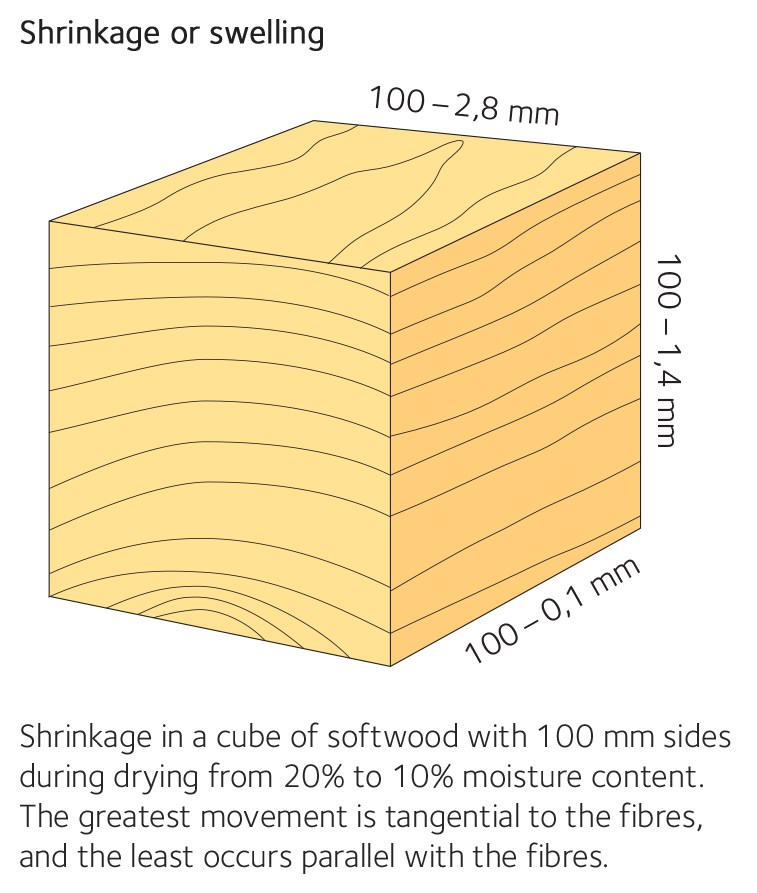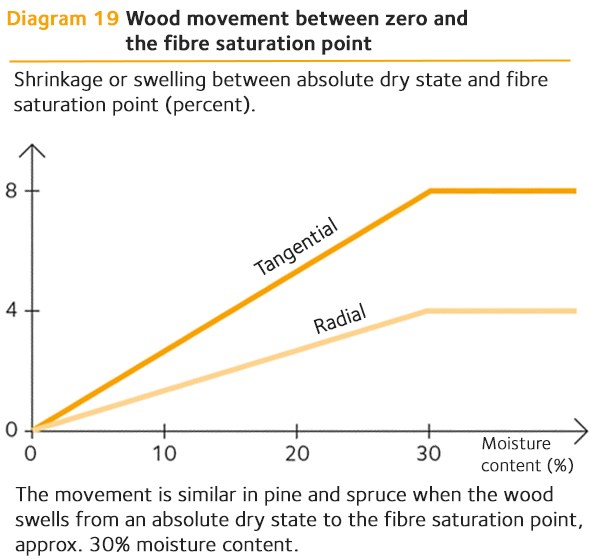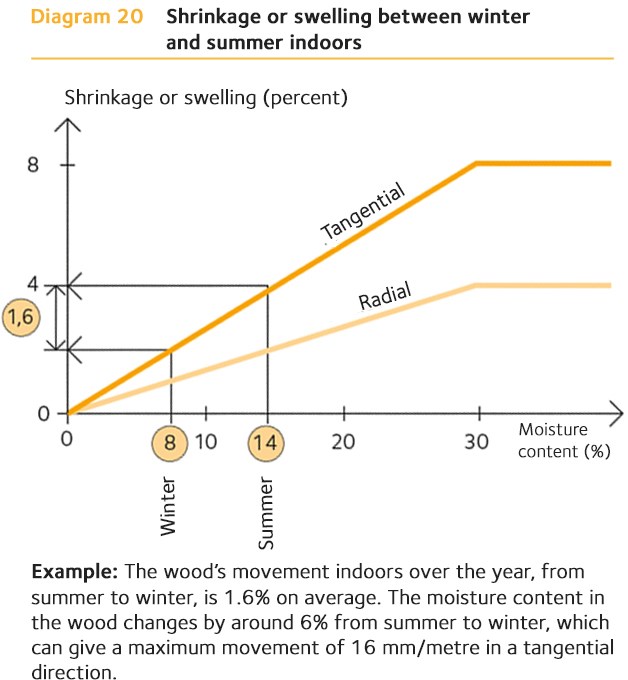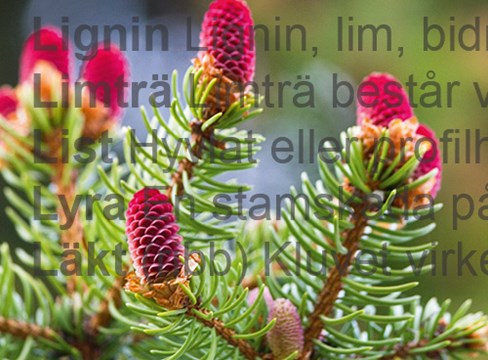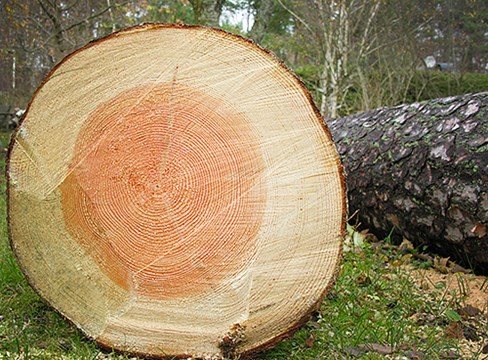Moisture-related wood movement
Wood is a hygroscopic material, which means that it absorbs moisture from the air during humid periods and releases moisture during dry periods. In the living tree, water and nutrients are transported via the sapwood in the outer part of the stem, while the inner parts are inactive, having been converted into heartwood. The moisture content of sapwood in newly felled timber may be as much as 160%, while the heartwood will be significantly drier at less than 50%.
The moisture in the wood takes two main forms: freely available water in the hollow cell cavities and water that is bonded to the cell walls. During the drying process, most of the freely available water in the fibres’ cell cavities evaporates first, followed by the water that is bonded to the cell walls.
The state in which the free water has evaporated but the cell walls are still saturated is referred to as fibre saturation. Drying has very little effect on the wood’s dimensions above the fibre saturation point. It is only when the water in the cell walls begins to be removed that the wood starts to shrink. Fibre saturation usually occurs with a moisture content of around 30%.
Wood shrinks to different degrees in different directions – least with the grain and most along the growth rings, see fig. 53. The curved nature of the growth rings means that the wood will bow and warp differently depending on the part of the log from which the piece of wood was taken, see fig. 54.
The wood first begins to shrink at the surface, with the inner parts shrinking later on. This, coupled with the directional variations in the shrinkage, creates a risk of seasoning checks and deformations if the drying process is left uncontrolled. The variation in shrinkage in the cross-section can also cause drying stresses that need to be reduced with a conditioning phase after drying. See the section Sawmill conditioned wood.
A board or plank rarely displays purely tangential or radial shrinkage. A rule of thumb is therefore that the average movement (shrinkage or swelling) for pine and spruce in both a radial and tangential direction is around 0.26% per percentage point of change in the moisture content. See table 11, for the percentage of shrinkage per 1 percentage point moisture content change for other woods.
Table 11 Average values for shrinkage in various wood species during drying, from fibre saturation to absolutely dry wood
|
Wood species |
Shrinkage |
Shrinkage in percent per 1 percentage point change in the moisture content
|
|||
|
Fibre direction, along length of stem, axial ba (%) |
Radial direction, across the growth rings, radial br (%)
|
Tangential direction, along the growth rings, bt (%)
|
Volume change (%)
|
||
|
Alder |
0.5 |
4.4 |
9.3 |
14.2 |
0.31 |
|
Ash |
0.2 |
5 |
8 |
13.2 |
0.27 |
|
Aspen |
0.2 |
3.8 |
8.7 |
12.7 |
0.29 |
|
Birch |
0.3 |
6.7 |
10.4 |
17.4 |
0.35 |
|
Beech |
0.3 |
5.8 |
11.8 |
17.9 |
0.39 |
|
Oak |
0.4 |
4 |
7.8 |
12.2 |
0.26 |
|
Pine |
0.4 |
4 |
7.7 |
12.1 |
0.26 |
|
Spruce |
0.3 |
3.6 |
7.8 |
11.7 |
0.26 |
|
Larch |
0.3 |
3.3–4.3 |
7.8–10.4 |
11.8 |
0.26 |
For practical calculations, 7% can be used as the average figure for movement in sawn pine and spruce timber, which corresponds to 0.24% per 1 percentage point change in the moisture content.
Example: A 145 mm wide floorboard with a moisture content of 17% is laid in a room with a climate equating to the wood’s equilibrium moisture content of 10%. The change in moisture content is 17−10 = 7 percentage points. The board shrinks 7 x 0.0026 x 145 mm = approx. 2.6 mm in width. The shrinkage will be half that size if the board is sawn in a radial direction rather than in a tangential direction, i.e. with vertical growth rings. Floorboard gaps will be half the size.
The wood’s movement is relatively slow, particularly in larger dimensions. It takes more than a year, for example, for the inner part of a thick timber wall to adapt to the surrounding climate.
The delivery moisture content for the wood from the sawmill was previously around 20% for planks and around 16% for boards. This was called “shipping dry”. Now the wood’s delivery moisture content is adapted more to the product or application, for example in line with the requirements in the product standards and in AMA Hus.
Since wood strives to achieve equilibrium with the air’s temperature and relative humidity, the moisture content will move towards the equilibrium moisture content, but this takes quite a long time.
Encased wood and joinery should have a moisture content that is as close as possible to the equilibrium moisture content for the finished structure’s climate. It is important to check the surface moisture content, which should be max 18% if the wood is to be encased. This will avoid major moisture-related movement and other adverse effects. See in figure 45, the moisture content a product moves towards over the months of the year – indoors and out.
The capacity to absorb water is different for spruce and pine. Spruce absorbs water slowly in both the heartwood and the sapwood. The absorption capacity of pine varies greatly between the heartwood and the sapwood. The heartwood of pine has around the same capacity to absorb water as spruce, while pine sapwood absorbs water many times faster. You should therefore avoid using pine side boards in weather-exposed applications such as external cladding, for which spruce is better suited. On the other hand, the good durability and slow moisture-related movement of pine heartwood means, for example, that windows made from heartwood are highly durable, keeping the risk of rot very low.
For floorboards, internal cladding and floor joists, the target moisture content should be 8, 12 and 16% respectively to minimise swelling or shrinkage, see table 10 and the relevant product standard.
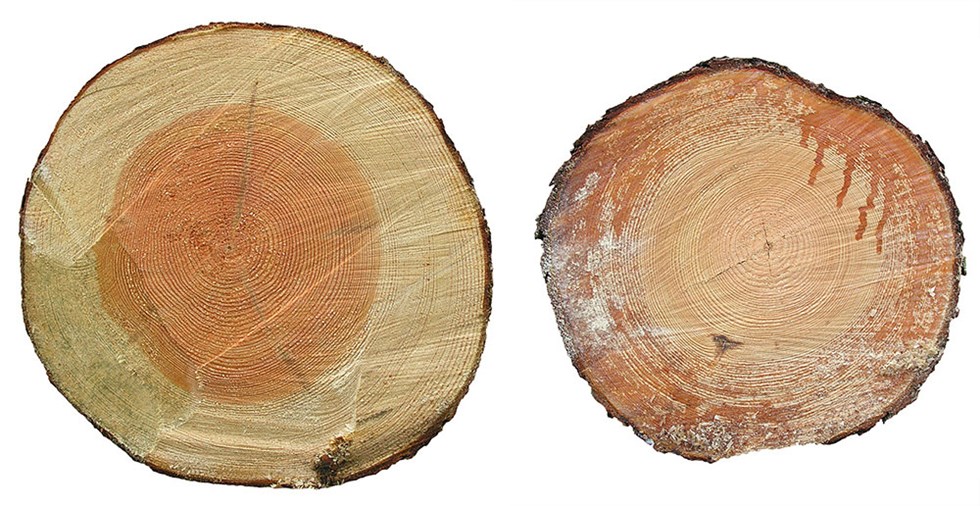
These pine logs were recently felled. The left image shows the root end and the extent of the pine heartwood. The right image shows the top end and how the transport of nutrients, in the fluid which runs through the sapwood in the log, has not yet stopped.
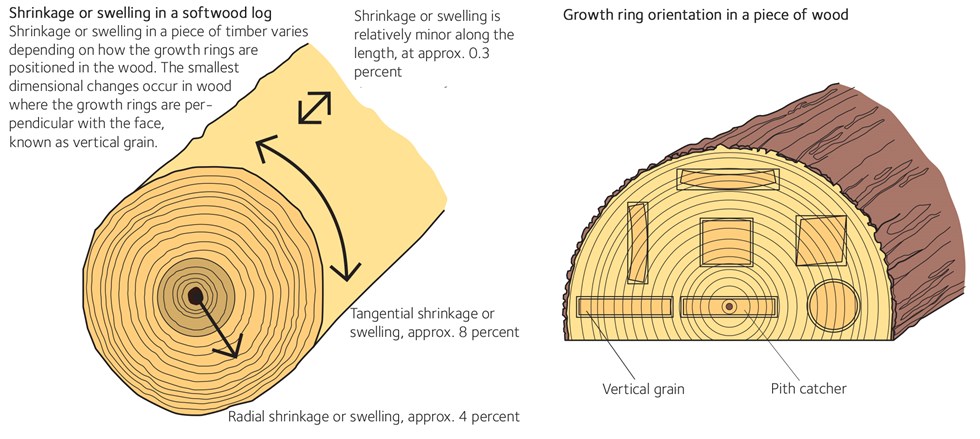
Fig. 53 Shrinkage or swelling in a softwood log from fresh to fully dry
Fig. 54 Growth ring orientation in a piece of wood

